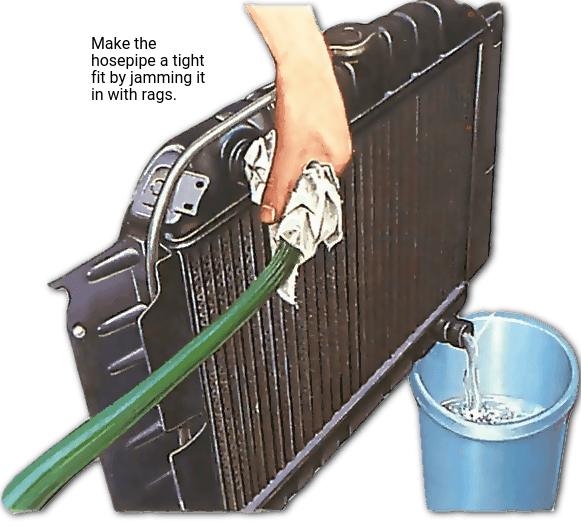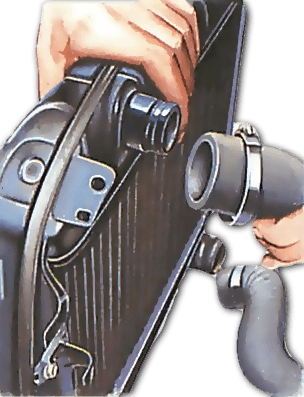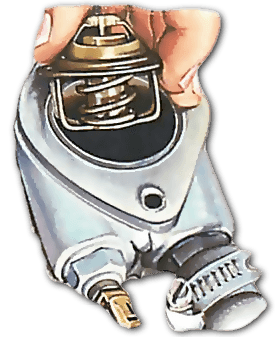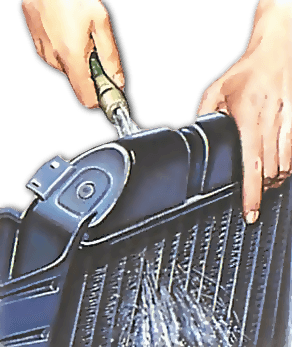How to flush an engine radiator
The Video Course teaches you everything about modern cars.

Over a period of years, sediment builds up in a car's cooling system even if antifreeze containing corrosion inhibitors is left in all year round.
Eventually the sediment will start to obstruct the water passages in the radiator and engine . Such obstruction causes overheating of the engine which, if it becomes severe, can lead to engine seizure.
If your engine is overheating and you have eliminated other possible causes, such as leaks (See Adjusting the static timing ), the water passages are probably choked or narrowed by sediment. To clear them, thoroughly flush the radiator and engine.

Before flushing, drain the old coolant from the system and discard it the sediment deposits will have contaminated it. Remember, however, that the antifreeze contained in the coolant is poisonous. Have a large container ready to collect it, for disposal later at your nearest dump for poisonous wastes.
With the engine cold, remove the pressure cap from the radiator or expansion tank . Turn the heater control to hot .
If the radiator has a drain plug, remove it; if there is a drain tap, open it - look in your car handbook to see which way it turns, as it can be broken easily.
If no coolant runs out, gently poke the hole clean with a piece of wire, or unscrew the tap completely.
If there is no tap or drain plug, disconnect the bottom hose at the radiator end.
There may also be a drain tap on the engine block . If so, open it.
How to flush a car radiator

Disconnect both hoses from the radiator. Push the end of a garden hose into the top radiator connection stub, and seal it with rags.
Refit the radiator pressure cap and turn the water on full. Flush until the water runs clear.
Check by catching some water in a glass jar and looking for sediment which you can see only in still water.

If the water does not clear in a few minutes, reverse flush the radiator. Seal the hose into the bottom stub. Tie a long plastic bag with a hole in the bottom to the top stub, to direct the coolant away from the engine and electrical components. Flush until the water runs clear.
Flushing the engine block
Disconnect the top hose from its stub on the thermostat housing above the water pump .

Unbolt the top of the housing and lift out the thermostat, noting which way up it fits . Refix the top of the empty housing.
Seal a garden hose into the housing stub. Flush until water runs clear from the bottom hose. This is reverse flushing: water normally flows up the engine.
Refit the radiator if you removed it, and put back the thermostat. Fit a new gasket in the thermostat housing, after smearing both sides of it with non-setting sealant . Bolt back the top.
Reconnect the hoses, renewing any damaged hoses or clips or any that are more than four years old.
Refill the system with clean water. Run the engine up to its normal working temperature and check for leaks.
Add antifreeze (See Checking and topping up car antifreeze coolant ) only when you are satisfied that there are no leaks.
Even in summer, use an antifreeze mixture — it contains anticorrosion additives . Ordinary tap water can cause rapid corrosion and partial blocking of the cooling system.
The coolant mixture is usually good for two or three years' winter and summer use, after which it should be replaced.
Cleaning radiator fins

Brush loose dirt from the fins of the radiator core with a nylon brush - not a wire brush, as the soft metal core is easily damaged. Do not poke it with a wire or a screwdriver.
If the core looks oily, spray it with a proprietary oil dispersant or apply an oil solvent with a soft brush.
The Ultimate Car Mechanics video course
Learn everything about modern cars from our new video series.
Learn more >-
We build a Mazda MX5 Miata from scratch
We start by tearing down and then rebuilding the whole car.
-
Every part explained
There's ridiculous detail on every part. Clearly and easily explained.
-
All modeled in 3D
We've created the most detailed 3D model ever produced so we can show you everything working.






